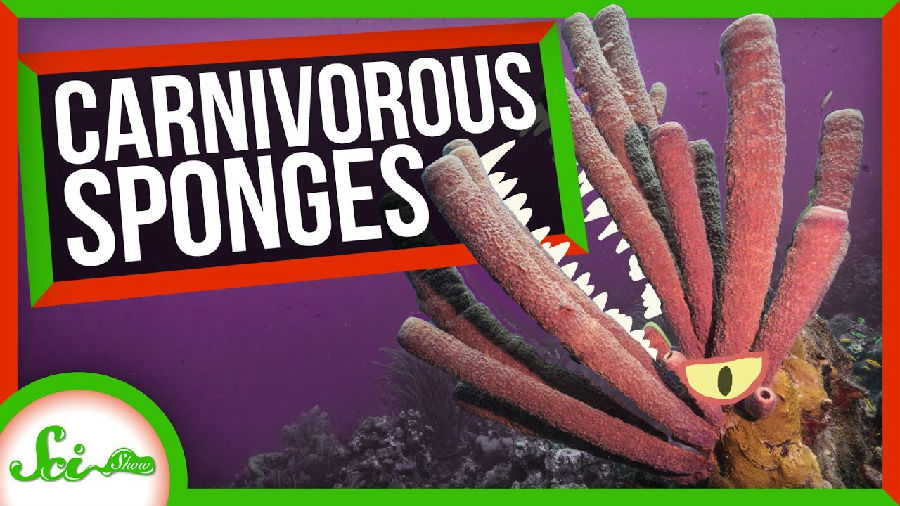So, sponges are pretty chill, right?
海绵相当轻松是吗?
They're just gentle filter-feeders that bask in the sunlight and absorb nutrients from the water around them.
它们只是温和的滤食性动物,沐浴在阳光下,从周围的水中吸收营养。
Except, that's not true of all sponges. And here's something you might not have expected: Some of them are carnivores!
但并不是所有的海绵都是这样。你可能想象不到:其中一些海绵是食肉动物!
Normally, a sponge absorbs nutrients with the help of its aquiferous system,
通常情况下,海绵在其含水层系统的帮助下吸收营养:
an internal series of canals, chambers, and spaces that filter water and nutrients.
它的水层系统是一系列的隧道、内室和空间用来过滤水和营养物质。
But sponges of the family Cladorhizidae have either reduced or entirely absent aquiferous systems.
但是刺角海绵科的海绵要么减少了含水系统,要么完全没有含水系统。
To get their energy, they've evolved a very different strategy: They catch and eat small animals.
为了获取能量,它们进化出了一种非常不同的策略:它们捕食小动物。
To do this, they've developed some pretty amazing adaptations.
为了做到这一点,它们已经进化出了一些非常惊人的适应能力。
For one, they've taken on strange, plant-like shapes.
首先,它们呈现出奇怪的植物状。
They often have stalks or branches reaching up off the seafloor, and from their bodies,
它们的茎或枝干经常从身体里伸出来,
long, thin filaments stretch out around them like fishing lines.
又长又细的丝状物像钓鱼线一样缠绕着它们。
Each of these filaments is then lined with tiny spines called spicules.
每一根丝状物上都排列着叫做海绵骨针的小刺。
And that's where stuff starts to get really cool.
事情从这里起变得很酷。
These spicules act like hook-and-loop fasteners to catch the little legs and hairs of tiny crustaceans or other animals
这些骨针就像搭扣一样扣住微小的甲壳类动物或其他动物的小腿和毛发
and they seem pretty effective. The prey captured by some of these sponges can be as long as eight millimeters.
并且它们似乎相当有效果。被海绵捕获的猎物可长达8毫米。

Which isn't bad for a sponge's dinner, especially since many sponges aren't huge themselves!
这当海绵的晚餐可不赖,尤其是很多海绵本身体积并不大!
Of course, catching the food is just the beginning. You still have to eat it somehow.
当然捕捉食物只是一个开始。你还得要吃进去。
And when these sponges are ready for their meal, they make use of another amazing ability: migrating cells.
当这些海绵准备进餐时,它们会利用另一个惊人的能力: 迁移细胞。
Like all organisms, sponges' bodies are made of cells.
和所有生物体一样,海绵的身体是由细胞组成的。
But sponges can do something pretty cool: Their cells can make trips across their bodies.
但是海绵可以做一些很酷的事情:它们的细胞可以在体内穿梭。
Some sponges may use this ability to help repair damaged body parts, and others use cell motion to slowly crawl across the seafloor.
一些海绵可能会利用这种能力来帮助修补身体受损部分,并且其他海绵会利用细胞运动在海底缓慢爬行。
But carnivorous sponges use their migrating cells as mobile stomachs.
但食肉类海绵将它们的迁移细胞充当移动的胃部。
Once prey is captured in their filaments, stem cells near the base of the sponge begin to multiply.
一旦丝状物捕捉到猎物,靠近海绵底部的干细胞就开始繁殖。
Then, they turn into digestive cells and swarm upward.
然后它们变成消化细胞并向上蜂拥。
Slowly but surely, they surround the prey and begin digesting it and absorbing its nutrients.
它们缓慢而坚定地包围猎物,开始消化和吸收其营养。
Some of these cells even produce their own digestive enzymes, while others harbor enzyme-producing bacteria.
一些细胞甚至会产生自己的消化酶,而另一些则含有产生酶的细菌。
So basically, these animals make a stomach, and then that stomach travels upwards to claim its meal!
所以基本上这些动物制造出了一个胃部,然后这个胃会向上走,要求进食!
For a large morsel, digestion can take eight to ten days. But afterward, the sponge is ready to feed again.
对于一大块食物老说,可能需要8到10天的消化时间。但之后,海绵就可以再次进食了。
You might expect such an odd lifestyle to be extremely rare,
你可能认为这种奇怪的生活方式非常罕见,
but scientists have identified more than one hundred seventy-five species of carnivorous sponges!
但科学家已经鉴定出了超过175种食肉海绵!
They think this might have happened because these animals live in nutrient-poor waters
他们认为这种方式的发生是因为这些动物生活在营养匮乏的水中
like inside sea caves, or hundreds or thousands of meters below the surface.
如海蚀洞内或在地表以下数百或数千米处。
Which makes them crummy places for filter-feeders,
这使得它们成为滤食性动物的寒酸场所,
so any sponges that live there have had to adapt and find new ways to get their food.
因此任何生活在那里的海绵都不得不适应并寻找新的获取食物的方法。
And apparently, along the way, they developed a taste for tiny critters.
显然,在此过程中,它们对小动物产生了兴趣。
It just goes to show that even the calmest-looking things in nature can secretly be really hardcore.
这只是表明,即使是自然界中看起来最温和的东西,实际上也可能是硬核。
Thanks for watching this episode of SciShow, which is brought to you by our patrons on Patreon!
感谢收看本期节目,本期节目有我们的赞助人赞助播出!
Thank you to everyone who supports the show, whether you've been doing it for a day or half a decade.
感谢每一位支持本节目的观众,不论是支持了我们一天还是5年。
We couldn't cover so many of these cool topics without you.
没有大家我们无法涵盖这么多有趣的话题。
And if you want to learn about becoming a patron, you can head over to patreon.com/SciShow.
如果大家想知道如何成为赞助人,请前往patreon.com/SciShow。


